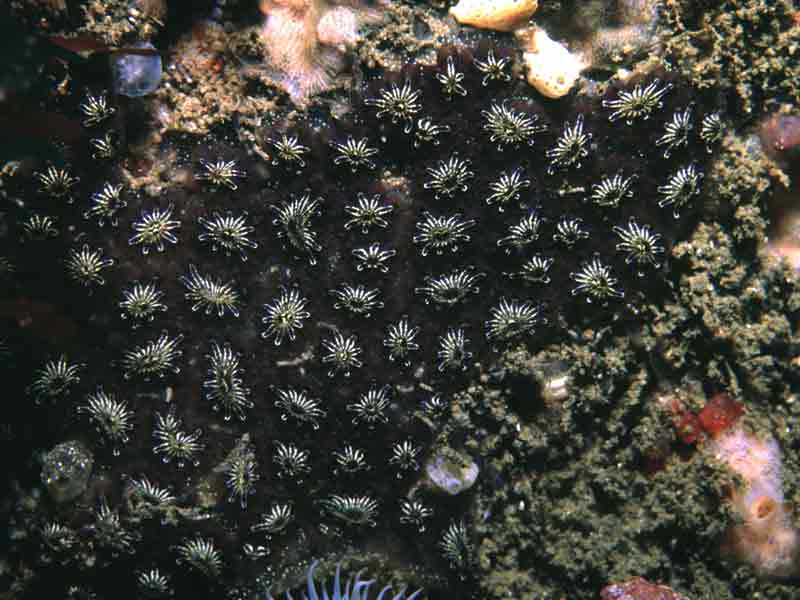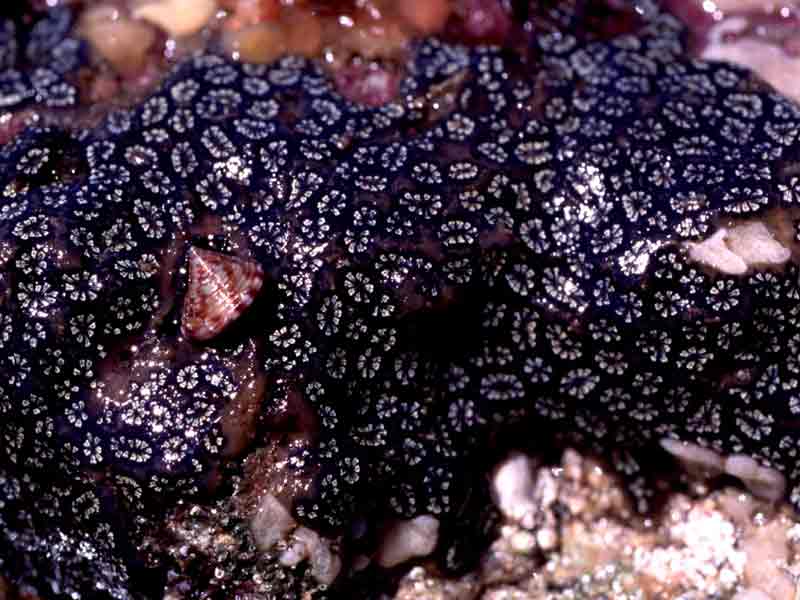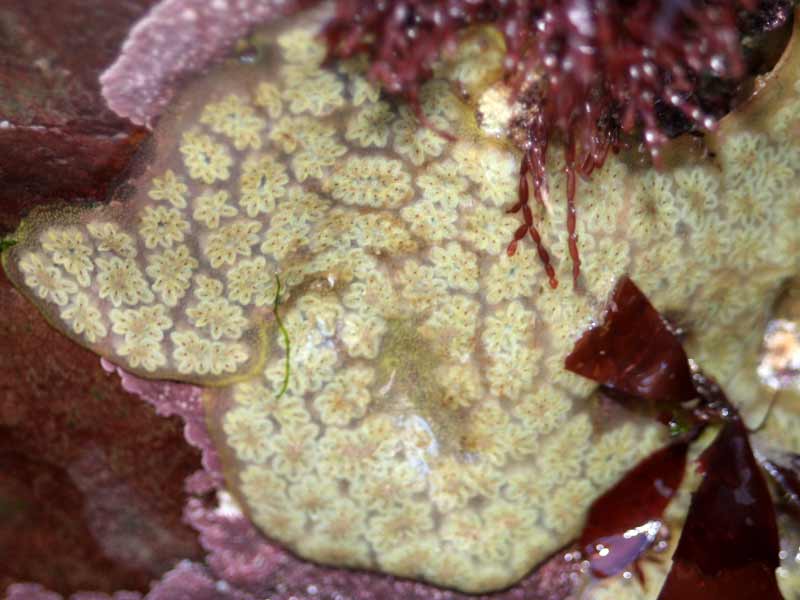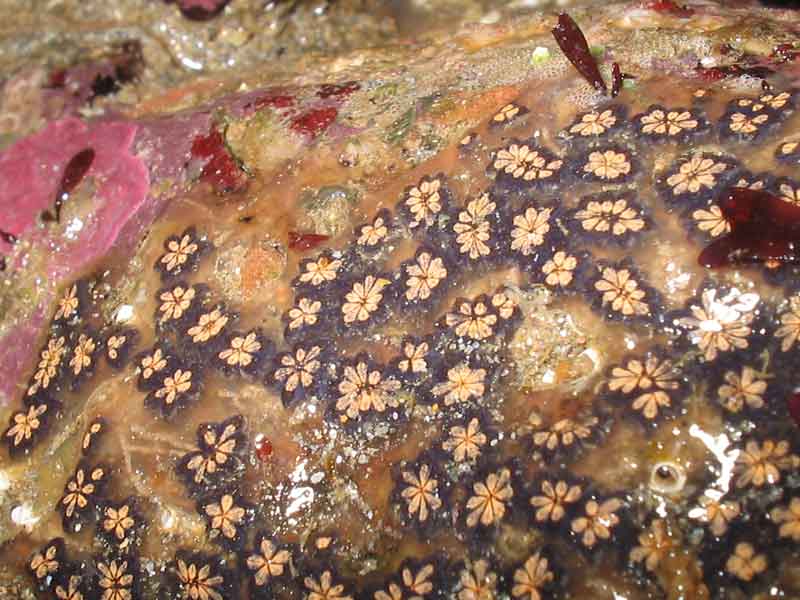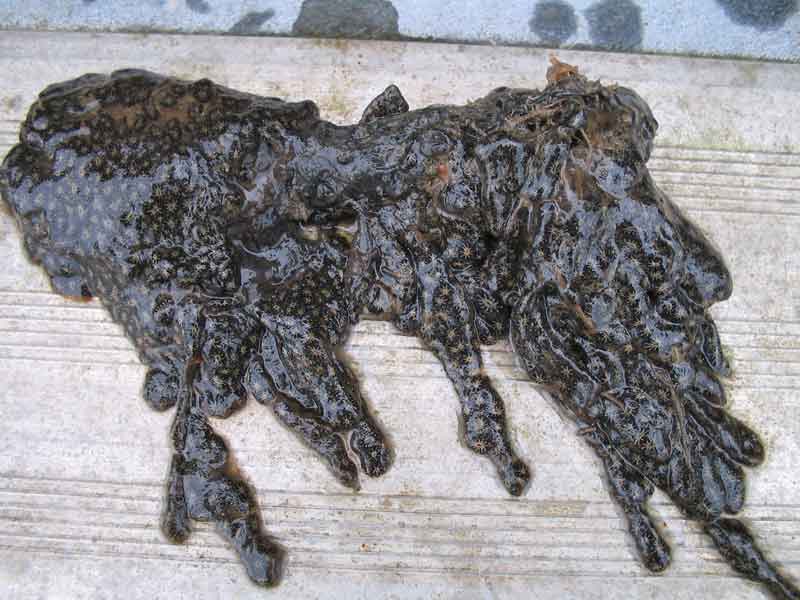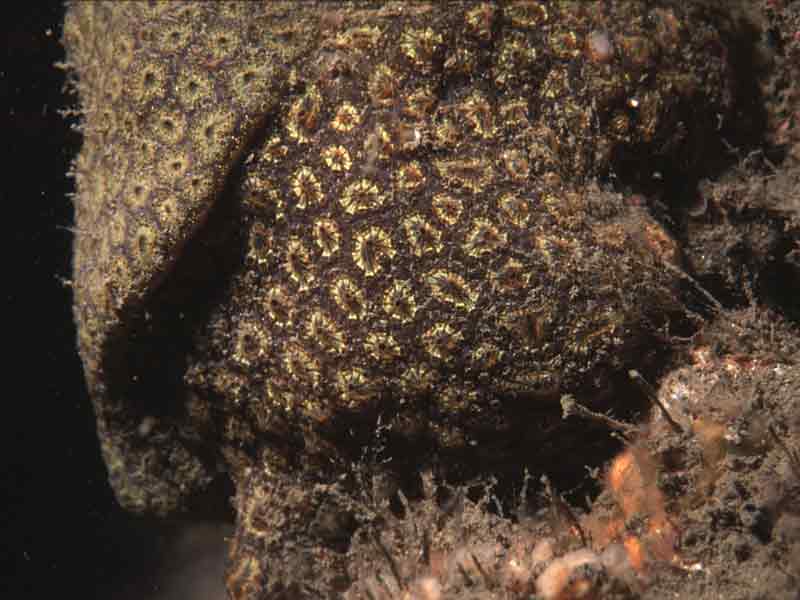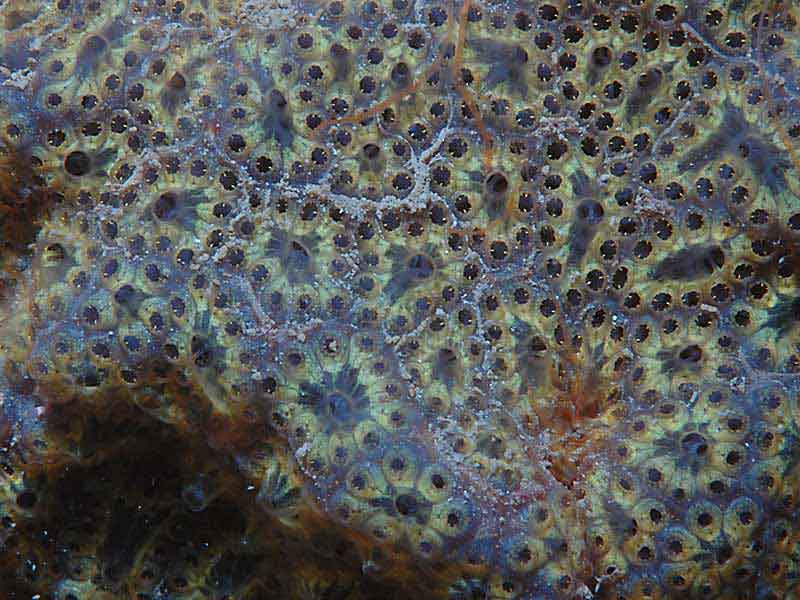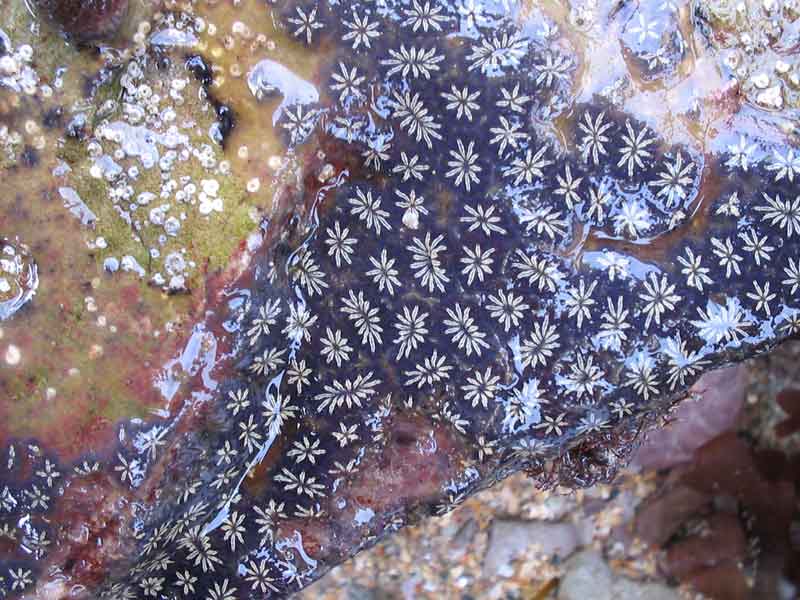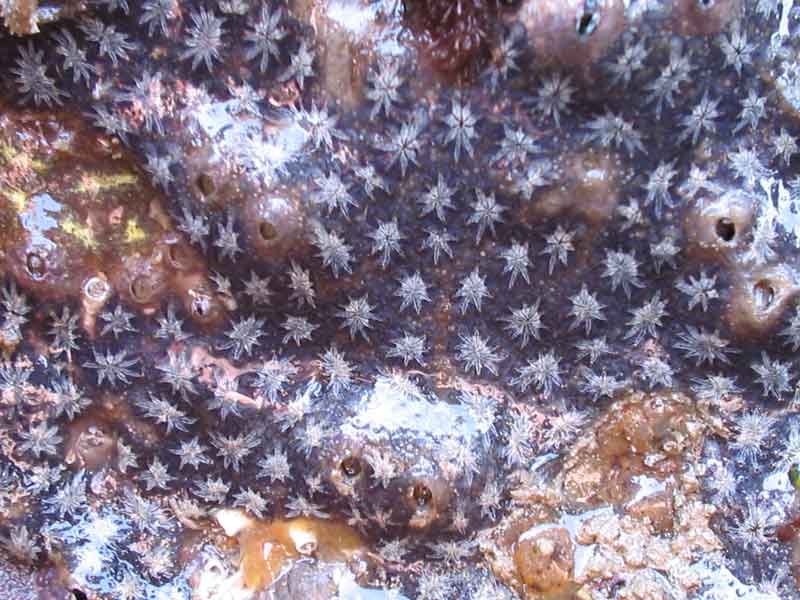Star ascidian (Botryllus schlosseri)
Distribution data supplied by the Ocean Biodiversity Information System (OBIS). To interrogate UK data visit the NBN Atlas.Map Help
| Researched by | Dr Keith Hiscock | Refereed by | This information is not refereed |
| Authority | (Pallas, 1766) | ||
| Other common names | - | Synonyms | - |
Summary
Description
Flat or fleshy colonies with zooids 2-4 mm across arranged in conspicuous star shaped systems, each with a central cloacal opening. Colonies vary greatly in colour including green, violet, brown and yellow.
Recorded distribution in Britain and Ireland
Found all around Britain and IrelandGlobal distribution
Present from the Faeroe Islands and west and south Norway to the Mediterranean including the Adriatic and Black Seas. Also present in the western Atlantic from Maine to New Jersey and in Florida.Habitat
Grows on a variety of stable substrata including algae and artificial substrata. Thrives in sheltered areas including docks. Although mainly found on the lower shore and in shallow depths, Berrill (1950) notes that it has been found at depths of several hundred metres.Depth range
Intertidal to ca. 200mIdentifying features
- Gelatinous often colourful colonies.
- The zooids arranged as 'stars' 2-4 mm across.
Additional information
No text entered
Listed by
- none -
Biology review
Taxonomy
| Level | Scientific name | Common name |
|---|---|---|
| Phylum | Chordata | Sea squirts, fish, reptiles, birds and mammals |
| Class | Ascidiacea | Sea squirts |
| Order | Stolidobranchia | |
| Family | Styelidae | |
| Genus | Botryllus | |
| Authority | (Pallas, 1766) | |
| Recent Synonyms | ||
Biology
| Parameter | Data | ||
|---|---|---|---|
| Typical abundance | |||
| Male size range | 1-20cm | ||
| Male size at maturity | |||
| Female size range | Medium(11-20 cm) | ||
| Female size at maturity | |||
| Growth form | Cushion | ||
| Growth rate | Data deficient | ||
| Body flexibility | |||
| Mobility | |||
| Characteristic feeding method | Active suspension feeder, Non-feeding | ||
| Diet/food source | |||
| Typically feeds on | Suspended particulates. | ||
| Sociability | |||
| Environmental position | Epifaunal | ||
| Dependency | Independent. | ||
| Supports | None | ||
| Is the species harmful? | No information | ||
Biology information
Colonies that encrust algae may completely cover their substratum and appear pendant-like. Provides a source of food for cowries (Trivia spp.).
Habitat preferences
| Parameter | Data |
|---|---|
| Physiographic preferences | Open coast, Offshore seabed, Strait or Sound, Sea loch or Sea lough, Ria or Voe, Estuary, Enclosed coast or Embayment |
| Biological zone preferences | Lower eulittoral, Lower infralittoral, Sublittoral fringe, Upper circalittoral, Upper infralittoral |
| Substratum / habitat preferences | Bedrock, Cobbles, Large to very large boulders, Small boulders |
| Tidal strength preferences | Moderately strong 1 to 3 knots (0.5-1.5 m/sec.), Strong 3 to 6 knots (1.5-3 m/sec.), Very strong > 6 knots (>3 m/sec.), Very weak (negligible), Weak < 1 knot (<0.5 m/sec.) |
| Wave exposure preferences | Exposed, Moderately exposed, Sheltered, Very exposed, Very sheltered |
| Salinity preferences | Full (30-40 psu), Variable (18-40 psu) |
| Depth range | Intertidal to ca. 200m |
| Other preferences | No text entered |
| Migration Pattern | Non-migratory or resident |
Habitat Information
Populations in the western Atlantic may have arrived on shipping and it is likely that, as a fast-growing fouling organism, Botryllus schlosseri may spread readily to other parts of the world.Life history
Adult characteristics
| Parameter | Data |
|---|---|
| Reproductive type | Permanent (synchronous) hermaphrodite |
| Reproductive frequency | No information |
| Fecundity (number of eggs) | 2-10 |
| Generation time | <1 year |
| Age at maturity | c. 50 days |
| Season | Insufficient information |
| Life span | <1 year |
Larval characteristics
| Parameter | Data |
|---|---|
| Larval/propagule type | - |
| Larval/juvenile development | Lecithotrophic |
| Duration of larval stage | < 1 day |
| Larval dispersal potential | 1 km -10 km |
| Larval settlement period |
Life history information
Up to eight eggs are produced per zooid. After fertilization and development to a tadpole stage, the tadpole is released and is free swimming for up to 36 hours (Berrill 1950; Berrill, 1975).Sensitivity review
The MarLIN sensitivity assessment approach used below has been superseded by the MarESA (Marine Evidence-based Sensitivity Assessment) approach (see menu). The MarLIN approach was used for assessments from 1999-2010. The MarESA approach reflects the recent conservation imperatives and terminology and is used for sensitivity assessments from 2014 onwards.
Physical pressures
Use / to open/close text displayed
| Intolerance | Recoverability | Sensitivity | Evidence / Confidence | |
Substratum loss [Show more]Substratum lossBenchmark. All of the substratum occupied by the species or biotope under consideration is removed. A single event is assumed for sensitivity assessment. Once the activity or event has stopped (or between regular events) suitable substratum remains or is deposited. Species or community recovery assumes that the substratum within the habitat preferences of the original species or community is present. Further details EvidenceBotryllus schlosseri is a sessile species dependant on the continued presence of the substratum to which it is attached. Removal of the substratum would remove the species. However, providing that suitable substratum remains after disturbance, settlement and growth from larvae is high. | High | High | Moderate | High |
Smothering [Show more]SmotheringBenchmark. All of the population of a species or an area of a biotope is smothered by sediment to a depth of 5 cm above the substratum for one month. Impermeable materials, such as concrete, oil, or tar, are likely to have a greater effect. Further details. EvidenceBotryllus schlosseri occurs in areas where high levels of smothering due to siltation may occur but is generally found where silt is unlikely to settle (down-facing or suspended surfaces) suggesting that it is intolerant of smothering. Smothering may prevent feeding and respiratory flows through the colony and the species may not survive burial. However, providing that suitable substratum is available after the smothering event is over, settlement and growth from larvae is high. | High | High | Moderate | Low |
Increase in suspended sediment [Show more]Increase in suspended sedimentBenchmark. An arbitrary short-term, acute change in background suspended sediment concentration e.g., a change of 100 mg/l for one month. The resultant light attenuation effects are addressed under turbidity, and the effects of rapid settling out of suspended sediment are addressed under smothering. Further details EvidenceBotryllus schlosseri occurs in areas where high levels of siltation and smothering may occur but is generally found where silt is unlikely to settle (down-facing or suspended surfaces) suggesting that it is intolerant of siltation. Silt may clog feeding and respiratory flows through the colony. However, providing that suitable substratum is available, settlement and growth from larvae is high. | High | High | Moderate | Moderate |
Decrease in suspended sediment [Show more]Decrease in suspended sedimentBenchmark. An arbitrary short-term, acute change in background suspended sediment concentration e.g., a change of 100 mg/l for one month. The resultant light attenuation effects are addressed under turbidity, and the effects of rapid settling out of suspended sediment are addressed under smothering. Further details Evidence | No information | |||
Desiccation [Show more]Desiccation
EvidenceBotryllus schlosseri occurs only in shaded areas on the lower shore in the intertidal where the atmosphere remains damp. Exposure to air and sunshine (for instance if boulders with colonies are overturned) would be likely to destroy colonies. However, providing that suitable substratum is available after a desiccation event, settlement and growth from larvae is high. | Intermediate | High | Low | Moderate |
Increase in emergence regime [Show more]Increase in emergence regimeBenchmark. A one hour change in the time covered or not covered by the sea for a period of one year. Further details EvidenceBotryllus schlosseri occurs only in shaded areas on the lower shore in the intertidal where the atmosphere remains damp. Increased exposure to air would be likely to destroy colonies. However, providing that suitable substratum is available after a emergence event, settlement and growth from larvae is high. | Intermediate | High | Low | Moderate |
Decrease in emergence regime [Show more]Decrease in emergence regimeBenchmark. A one hour change in the time covered or not covered by the sea for a period of one year. Further details Evidence | No information | |||
Increase in water flow rate [Show more]Increase in water flow rateA change of two categories in water flow rate (view glossary) for 1 year, for example, from moderately strong (1-3 knots) to very weak (negligible). Further details EvidenceWater flow rate is important for maintaining colonies free of silt where they occur in sheltered areas. If water flow rate is decreased in such areas, and siltation occurs, colonies are likely to be adversely affected. However, once a high water flow rate is regained, settlement and growth from larvae is high. | Intermediate | High | Low | Low |
Decrease in water flow rate [Show more]Decrease in water flow rateA change of two categories in water flow rate (view glossary) for 1 year, for example, from moderately strong (1-3 knots) to very weak (negligible). Further details Evidence | No information | |||
Increase in temperature [Show more]Increase in temperature
For intertidal species or communities, the range of temperatures includes the air temperature regime for that species or community. Further details EvidenceBotryllus schlosserioccurs from sub-arctic to warm temperate conditions and most likely tolerates a wide range of temperatures. Recolonization of suitable substrata would be rapid following once temperatures return to normal. | Low | Very high | Very Low | Moderate |
Decrease in temperature [Show more]Decrease in temperature
For intertidal species or communities, the range of temperatures includes the air temperature regime for that species or community. Further details Evidence | No information | |||
Increase in turbidity [Show more]Increase in turbidity
EvidenceBotryllus schlosserioccurs in areas where high levels of turbidity occur although, as a passive suspension feeder, it may be susceptible to clogging (see siltation above). Increased turbidity may decrease phytoplankton productivity which may indirectly decrease food availability. Recolonization of suitable substrata would be rapid once turbidity returned to normal. | Low | Immediate | Not sensitive | Low |
Decrease in turbidity [Show more]Decrease in turbidity
Evidence | No information | |||
Increase in wave exposure [Show more]Increase in wave exposureA change of two ranks on the wave exposure scale (view glossary) e.g., from Exposed to Extremely exposed for a period of one year. Further details EvidenceIncrease in wave exposure or storm events would remove predominantly the plants on which Botryllus schlosseri grows and therefore incidentally Botryllus schlosseri. Speed of recovery would depend on regrowth rates of the plant substrata. | Intermediate | Moderate | Moderate | Low |
Decrease in wave exposure [Show more]Decrease in wave exposureA change of two ranks on the wave exposure scale (view glossary) e.g., from Exposed to Extremely exposed for a period of one year. Further details Evidence | No information | |||
Noise [Show more]Noise
EvidenceBotryllus schlosseri has no organs for detecting noise. | Tolerant | Not relevant | Not sensitive | High |
Visual presence [Show more]Visual presenceBenchmark. The continuous presence for one month of moving objects not naturally found in the marine environment (e.g., boats, machinery, and humans) within the visual envelope of the species or community under consideration. Further details EvidenceBotryllus schlosseri has no organs for visual perception. | Tolerant | Not relevant | Not sensitive | Moderate |
Abrasion & physical disturbance [Show more]Abrasion & physical disturbanceBenchmark. Force equivalent to a standard scallop dredge landing on or being dragged across the organism. A single event is assumed for assessment. This factor includes mechanical interference, crushing, physical blows against, or rubbing and erosion of the organism or habitat of interest. Where trampling is relevant, the evidence and trampling intensity will be reported in the rationale. Further details. EvidenceAbrasion from sand is likely to be tolerated and Botryllus schlosseri occurs attached to algae on surf beaches. However, abrasion caused by mobile hard substrata, and anchor or dredge, is likely to remove colonies. Recolonization of suitable substrata would be rapid following cessation of abrasion. | Intermediate | High | Low | Low |
Displacement [Show more]DisplacementBenchmark. Removal of the organism from the substratum and displacement from its original position onto a suitable substratum. A single event is assumed for assessment. Further details EvidenceBotryllus schlosseri is permanently attached to the substratum and displacement is likely to have the same effect as substratum loss. Speed of recolonization would depend on the presence of suitable substrata. | High | Moderate | Moderate | Low |
Chemical pressures
Use [show more] / [show less] to open/close text displayed
| Intolerance | Recoverability | Sensitivity | Evidence / Confidence | |
Synthetic compound contamination [Show more]Synthetic compound contaminationSensitivity is assessed against the available evidence for the effects of contaminants on the species (or closely related species at low confidence) or community of interest. For example:
The evidence used is stated in the rationale. Where the assessment can be based on a known activity then this is stated. The tolerance to contaminants of species of interest will be included in the rationale when available; together with relevant supporting material. Further details. EvidenceRecolonization following cessation of exposure to a damaging non-persistent chemical is likely to be rapid. | No information | Not relevant | No information | Not relevant |
Heavy metal contamination [Show more]Heavy metal contaminationEvidenceRecolonization following cessation of exposure to a damaging non-persistent chemical is likely to be rapid. | No information | Not relevant | No information | Not relevant |
Hydrocarbon contamination [Show more]Hydrocarbon contaminationEvidenceRecolonization following cessation of exposure to a damaging non-persistent hydrocarbon is likely to be rapid. | No information | Not relevant | No information | Not relevant |
Radionuclide contamination [Show more]Radionuclide contaminationEvidenceNo recorded adverse effects of radionuclides on Botryllus schlosseri or similar species have been found. | No information | Not relevant | No information | Not relevant |
Changes in nutrient levels [Show more]Changes in nutrient levelsEvidenceNo recorded adverse effects of nutrients on Botryllus schlosseri or similar species were found. | Low | High | Low | Very low |
Increase in salinity [Show more]Increase in salinity
EvidenceBotryllus schlosseri lives in enclosed waters including docks and in estuaries where salinity is variable. However, its absence from low salinity conditions in upper estuaries and lagoons suggests that colonies will be intolerant of low salinities. Recolonization following cessation of exposure to low salinity is likely to be rapid. | Intermediate | High | Low | Moderate |
Decrease in salinity [Show more]Decrease in salinity
Evidence | No information | |||
Changes in oxygenation [Show more]Changes in oxygenationBenchmark. Exposure to a dissolved oxygen concentration of 2 mg/l for one week. Further details. EvidenceBotryllus schlosseri lives in habitats where periods of calm conditions may result in short term reduced oxygen levels. However, no studies relevant to de-oxygenation effects have been found. | Intermediate | High | Low | Very low |
Biological pressures
Use [show more] / [show less] to open/close text displayed
| Intolerance | Recoverability | Sensitivity | Evidence / Confidence | |
Introduction of microbial pathogens/parasites [Show more]Introduction of microbial pathogens/parasitesBenchmark. Sensitivity can only be assessed relative to a known, named disease, likely to cause partial loss of a species population or community. Further details. EvidenceNo information was found concerning pathogens or parasites in Botryllus schlosseri. | No information | High | No information | Very low |
Introduction of non-native species [Show more]Introduction of non-native speciesSensitivity assessed against the likely effect of the introduction of alien or non-native species in Britain or Ireland. Further details. EvidenceSome non-native species (Sargassum muticum) provide additional substrata for colonization. | Tolerant* | Not relevant | Not sensitive* | Low |
Extraction of this species [Show more]Extraction of this speciesBenchmark. Extraction removes 50% of the species or community from the area under consideration. Sensitivity will be assessed as 'intermediate'. The habitat remains intact or recovers rapidly. Any effects of the extraction process on the habitat itself are addressed under other factors, e.g. displacement, abrasion and physical disturbance, and substratum loss. Further details. EvidenceThis species is not targeted for extraction. | Not relevant | Not relevant | Not relevant | High |
Extraction of other species [Show more]Extraction of other speciesBenchmark. A species that is a required host or prey for the species under consideration (and assuming that no alternative host exists) or a keystone species in a biotope is removed. Any effects of the extraction process on the habitat itself are addressed under other factors, e.g. displacement, abrasion and physical disturbance, and substratum loss. Further details. EvidenceExtraction of algae on which Botryllus schlosseri grows will remove the Botryllus schlosseri. Colonization of new algal substrata will be high once algae have grown. | High | Moderate | Moderate | Low |
Additional information
No text enteredImportance review
Policy/legislation
- no data -
Status
| National (GB) importance | - | Global red list (IUCN) category | - |
Non-native
| Parameter | Data |
|---|---|
| Native | - |
| Origin | - |
| Date Arrived | Not relevant |
Importance information
-none-Bibliography
Berrill, N.J., 1950. The Tunicata with an account of the British species. London: Ray Society.
Berrill, N.J., 1975. Chordata: Tunicata. In Reproduction of marine Invertebrates, vol. II, (ed. A.C. Geise & J.S. Pearse), pp. 241-282. New York: Academic Press.
Chadwick-Furman, N.E., & Weissman, I.L., 1995. Life histories and senescence of Botryllus schlosseri (Chordata: Ascidiacea) in Monterey Bay. Biological Bulletin, Marine Biological Laboratory, Woods Hole, 189, 36-41.
Howson, C.M. & Picton, B.E., 1997. The species directory of the marine fauna and flora of the British Isles and surrounding seas. Belfast: Ulster Museum. [Ulster Museum publication, no. 276.]
Rumohr, H. & Kujawski, T., 2000. The impact of trawl fishery on the epifauna of the southern North Sea. ICES Journal of Marine Science, 57, 1389-1394.
Datasets
Bristol Regional Environmental Records Centre, 2017. BRERC species records recorded over 15 years ago. Occurrence dataset: https://doi.org/10.15468/h1ln5p accessed via GBIF.org on 2018-09-25.
Centre for Environmental Data and Recording, 2018. IBIS Project Data. Occurrence dataset: https://www.nmni.com/CEDaR/CEDaR-Centre-for-Environmental-Data-and-Recording.aspx accessed via NBNAtlas.org on 2018-09-25.
Centre for Environmental Data and Recording, 2018. Ulster Museum Marine Surveys of Northern Ireland Coastal Waters. Occurrence dataset https://www.nmni.com/CEDaR/CEDaR-Centre-for-Environmental-Data-and-Recording.aspx accessed via NBNAtlas.org on 2018-09-25.
Cofnod – North Wales Environmental Information Service, 2018. Miscellaneous records held on the Cofnod database. Occurrence dataset: https://doi.org/10.15468/hcgqsi accessed via GBIF.org on 2018-09-25.
Dorset Environmental Records Centre, 2018. Ross Coral Mapping Project - NBN South West Pilot Project Case Studies. Occurrence dataset:https://doi.org/10.15468/mnlzxc accessed via GBIF.org on 2018-09-25.
Environmental Records Information Centre North East, 2018. ERIC NE Combined dataset to 2017. Occurrence dataset: http://www.ericnortheast.org.ukl accessed via NBNAtlas.org on 2018-09-38
Fenwick, 2018. Aphotomarine. Occurrence dataset http://www.aphotomarine.com/index.html Accessed via NBNAtlas.org on 2018-10-01
Fife Nature Records Centre, 2018. St Andrews BioBlitz 2014. Occurrence dataset: https://doi.org/10.15468/erweal accessed via GBIF.org on 2018-09-27.
Fife Nature Records Centre, 2018. St Andrews BioBlitz 2015. Occurrence dataset: https://doi.org/10.15468/xtrbvy accessed via GBIF.org on 2018-09-27.
Fife Nature Records Centre, 2018. St Andrews BioBlitz 2016. Occurrence dataset: https://doi.org/10.15468/146yiz accessed via GBIF.org on 2018-09-27.
Kent Wildlife Trust, 2018. Biological survey of the intertidal chalk reefs between Folkestone Warren and Kingsdown, Kent 2009-2011. Occurrence dataset: https://www.kentwildlifetrust.org.uk/ accessed via NBNAtlas.org on 2018-10-01.
Kent Wildlife Trust, 2018. Kent Wildlife Trust Shoresearch Intertidal Survey 2004 onwards. Occurrence dataset: https://www.kentwildlifetrust.org.uk/ accessed via NBNAtlas.org on 2018-10-01.
Manx Biological Recording Partnership, 2017. Isle of Man wildlife records from 01/01/2000 to 13/02/2017. Occurrence dataset: https://doi.org/10.15468/mopwow accessed via GBIF.org on 2018-10-01.
Manx Biological Recording Partnership, 2018. Isle of Man historical wildlife records 1995 to 1999. Occurrence dataset: https://doi.org/10.15468/lo2tge accessed via GBIF.org on 2018-10-01.
Manx Biological Recording Partnership, 2022. Isle of Man historical wildlife records 1990 to 1994. Occurrence dataset:https://doi.org/10.15468/aru16v accessed via GBIF.org on 2024-09-27.
Merseyside BioBank., 2018. Merseyside BioBank (unverified). Occurrence dataset: https://doi.org/10.15468/iou2ld accessed via GBIF.org on 2018-10-01.
National Trust, 2017. National Trust Species Records. Occurrence dataset: https://doi.org/10.15468/opc6g1 accessed via GBIF.org on 2018-10-01.
NBN (National Biodiversity Network) Atlas. Available from: https://www.nbnatlas.org.
OBIS (Ocean Biodiversity Information System), 2025. Global map of species distribution using gridded data. Available from: Ocean Biogeographic Information System. www.iobis.org. Accessed: 2025-04-02
Outer Hebrides Biological Recording, 2018. Invertebrates (except insects), Outer Hebrides. Occurrence dataset: https://doi.org/10.15468/hpavud accessed via GBIF.org on 2018-10-01.
South East Wales Biodiversity Records Centre, 2023. SEWBReC Marine and other Aquatic Invertebrates (South East Wales). Occurrence dataset:https://doi.org/10.15468/zxy1n6 accessed via GBIF.org on 2024-09-27.
Yorkshire Wildlife Trust, 2018. Yorkshire Wildlife Trust Shoresearch. Occurrence dataset: https://doi.org/10.15468/1nw3ch accessed via GBIF.org on 2018-10-02.
Citation
This review can be cited as:
Last Updated: 08/05/2008

